EXCLUSIVEThe dried-up lake in Mexico fuelling fears AI technology is an environmental catastrophe in the making
Standing on the bone-dry bed of what used to be one of the biggest lakes in Mexico gives one an eerie sense of what the end of the world could look like.
'Everything started to dry up a few years ago,' says farmer Carmen Ruiz, prodding the crumbling, cracked earth where Lake Constitucion used to be.
Occupying an area of more than 2,000 acres in the state of Queretaro, the lake was once larger than Gibraltar.
The Ruiz family used to spend their days raising chickens by the water and growing root vegetables alongside lines of fresh corn that stretched to the horizon, but now the lake has all but gone and, along with thousands of families like them, they are struggling to survive.
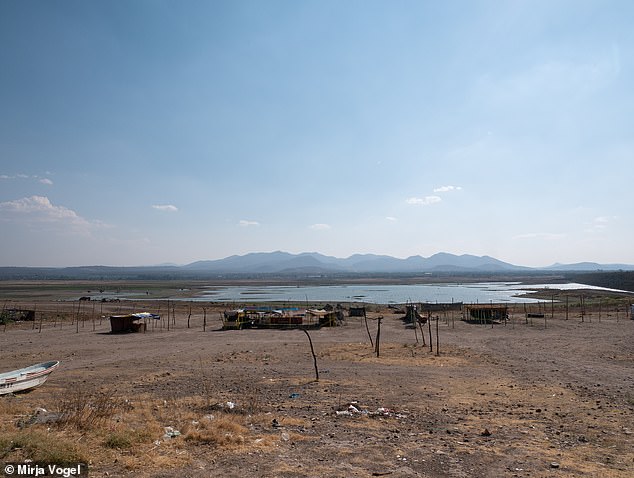
Standing on the bone-dry bed of what used to be one of the biggest lakes in Mexico, Lake Constitucion, gives one an eerie sense of what the end of the world could look like
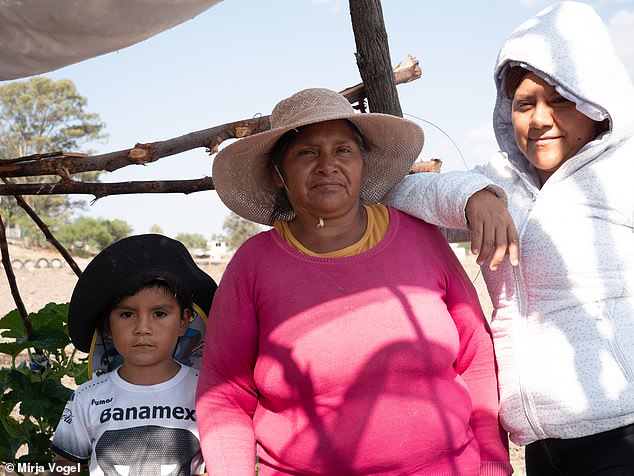
Maria Ruiz (in pink) shields herself from the searing sun alongside her daughter and grandson, who work together on what is left of the family farm
Climate change is one of the reasons, but what they say is threatening them even more is something that was supposed to make all our lives better, cleaner, healthier and smarter: Artificial Intelligence (AI).
The sudden arrival and growth of AI is being hailed as the next industrial revolution, a discovery as important as the wheel, fire or controlled flight. Proponents say it will advance all human activity, from medicine to engineering, transportation to pharmacology, quantum mechanics to architecture. But while governments and corporations alike rush headlong to embrace AI, growing numbers of environmentalists and digital computing experts are warning that we could be sleepwalking into a catastrophic ecological disaster.

'Everything started to dry up a few years ago,' says farmer Carmen Ruiz, who used to spend his days raising chickens by the water and growing root vegetables
Because behind the shiny new world of AI are voracious systems that require vast amounts of energy to power them, minerals to make component parts including microchips and, as the farmers of Queretaro are finding out, water to cool their computers, which are vulnerable to overheating due to their colossal processing power.
'Everything is going insane and it's going to get much worse —we're looking at an environmental catastrophe in the making,' says Gerry McGovern, author of World Wide Waste: How Digital Is Killing The Planet And What To Do About It. 'AI is growing exponentially and the problem with exponential growth is that it creeps up on you slowly at first — but then overwhelms you very suddenly.'
Earlier this month, Google provided a stark illustration of this trend when it reported a 48 per cent rise in CO2 emissions in the past five years. In 2022-23, mainly through the vast amounts of electricity it consumes, the firm was responsible for more than 14 million tonnes of CO2 emitted into the atmosphere, the equivalent to that pumped out by 29 gas-fired power stations in a year.
The figures run a coach and horses through Google's stated aim to be carbon-neutral by 2030, and it says the principal culprit is its data centres, the huge factory-like structures in which millions upon millions of computers — known as 'servers' — need to be housed all around the world. As these centres embrace AI technology, the resources needed to power them vastly increases.
AI has only been in the public consciousness since the arrival of a 'chatbot' named ChatGPT, posted to the web by tech company OpenAI in November 2022. For the first time, users could have a typed conversation with a digital entity that could respond realistically, search for information, plan their holiday, do their homework and even crack jokes.
Within five days it had 1 million users. Within two months, it had 100 million, and today ChatGPT and counterparts from Google (Bard), Microsoft (Copilot) and Meta (Meta AI) have billions.
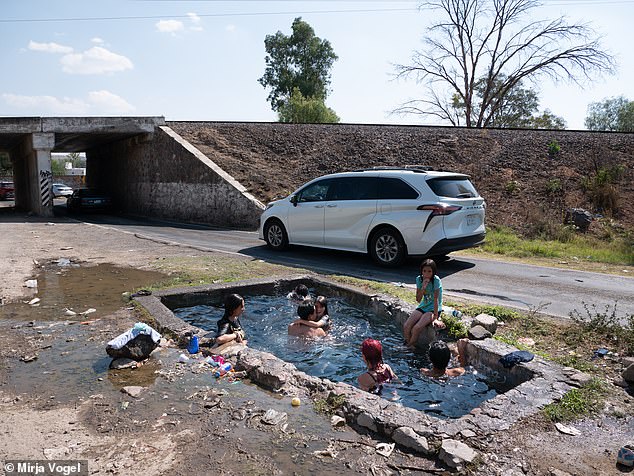
A young family bask in a man-made pool of water next to the busy roadside 35km south of one of Amazon's cloud data sites in Queretaro, central Mexico
AI isn't actually intelligent in the sense that it thinks for itself. AI programs such as Bard are called Large Language Models (LLMs) because in order to 'learn' they are fed huge amounts of data. Within this data — billions of pages gleaned from the internet — LLMs recognise patterns within previous references to any given subject and to prior questions and responses relating to it.
So when you ask an LLM chatbot a question, it is not reasoning and giving you an answer based on what it 'thinks'; it is calculating which response is statistically most appropriate out of trillions of pieces of information from almost all of the internet.
According to McGovern, an AI search using this methodology consumes around ten times more energy than a Google search, which simply recovers answers from an index rather than scouring the whole web.
The servers that make AI work use special microchips called 'graphics processing units' (GPUs) that require up to 15 times more energy to make than traditional microchips. They also need more types of minerals to manufacture — 60 rather than 11 — and they are using ever-increasing amounts of energy to operate as AI models become more complex.
For example, in 2020 it took approximately 27 kilowatt-hours of energy to 'train' an AI model (a kilowatt-hour is the amount of energy used by a 1,000-watt appliance in an hour). By 2022, the models were becoming so much bigger that the energy consumption had risen to 1 million kilowatts — a 37,000-fold increase.
This has led to an explosion in demand for data centres. In 2022, Google's worldwide data centre usage increased by 20 per cent compared to the previous year. Microsoft's increased by 34 per cent. According to American analysts P&S Intelligence, the data centre market is worth £270 billion today. By 2030 it is expected to grow to £492 billion.
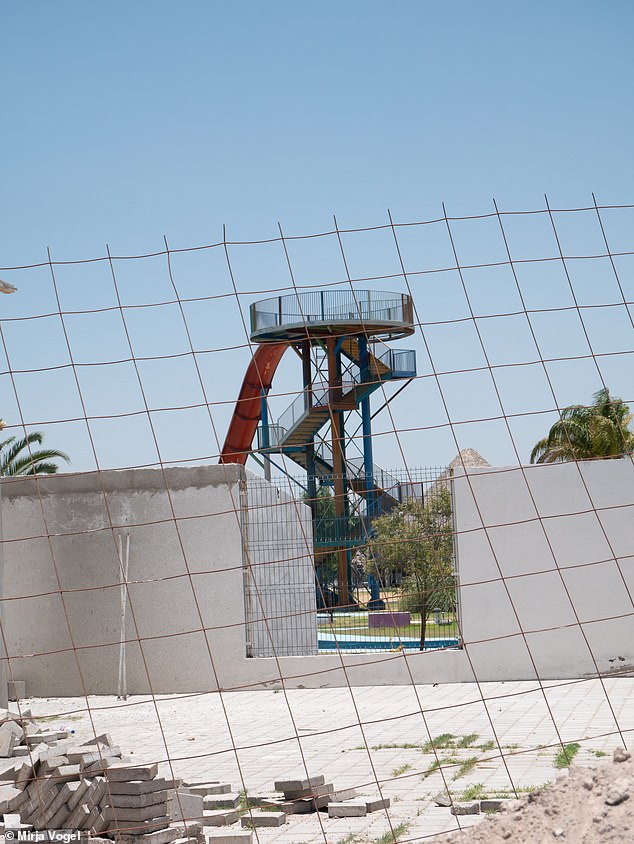
Behind the latest construction site in Queretaro, an abandoned water park hasn't opened its doors in months

A once-renowned seafood restaurant lies empty and disused along with the Lake Constitucion dam
In the UK, where the previous Conservative government had encouraged foreign investment in AI (Labour have been cooler on the AI revolution, preferring greater state oversight, but we await their official strategy), data centres are expanding.
Google is spending £1 billion on a new centre in Waltham Cross, Hertfordshire. Microsoft, meanwhile, has promised to double its data centre footprint by adding 20,000 more GPUs to its UK infrastructure by 2026 as part of a £2.5 billion investment, with sites in London, Cardiff and potentially the north of England set to grow. Because the GPUs use more energy, they give off more heat inside the data centres and so they need to be cooled by systems that use lots of water.
Last year, researchers at the University of California Riverside published a paper predicting that data centres worldwide would be using up to 6.6 billion cubic metres of water by 2027 — equivalent to half the UK's annual usage.
Worst affected by shortages because of the need for all this water are some emerging and developing countries where tech companies can set up their operations with less environmental and legal regulation than in their own country, invariably the U.S.
Among these, alarm bells are ringing in Mexico, Costa Rica and parts of Africa where communities are already in competition with data centres over water and mineral resources.
In 2020, Microsoft announced a plan to build a 'cloud data region' in Queretaro, Mexico, featuring at least three 'availability zones' for its cloud computing platform, Azure. Each zone would have one or more of the water and gas-guzzling data centres — one of them less than 20 miles from Lake Constitucion. The Mexican government welcomed Microsoft, then Amazon and Google, and designated Queretaro as a cloud computing hub for Latin America. The tech companies and the government have promised the AI revolution will bring jobs to the area, but locals are unimpressed.
When the Mail visits the outskirts of San Juan del Rio, a city of 250,000 people 26 miles south of one of Microsoft and Amazon's data centres, one resident says: 'If we don't have water to drink, clean and shower with, or fresh food to eat, then what is the point of having more jobs in the area?'
Many locals seem desperate. They say droughts caused by climate change are already a challenge — but the data centres could be the final nail in their collective coffin.
'It hasn't rained here since last July,' says ranch and farm owner, Jose Trejo. His farm is dry, his fields arid. 'Farming families over there can't afford to buy extra water from private companies when they run out.
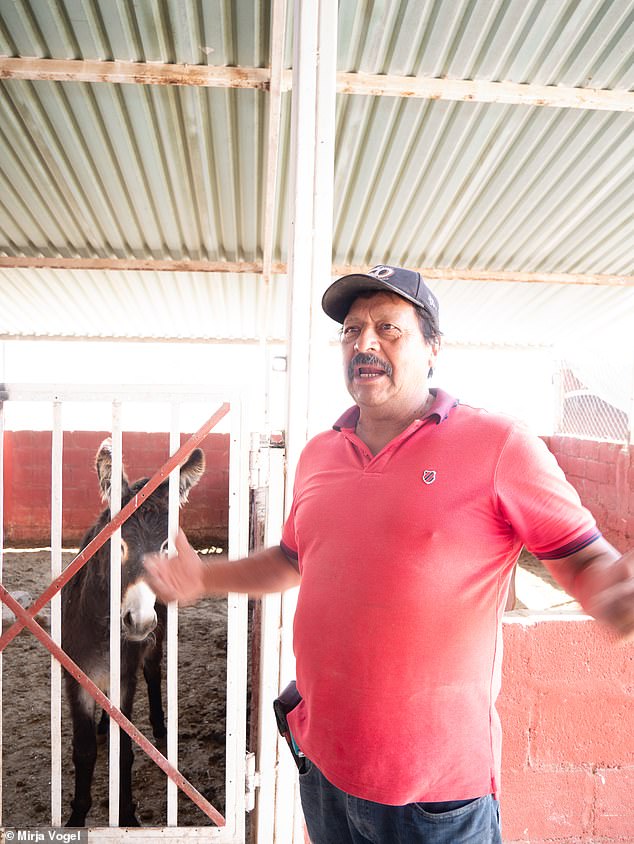
'It hasn't rained here since last July,' says ranch and farm owner, Jose Trejo. His farm is dry, his fields arid
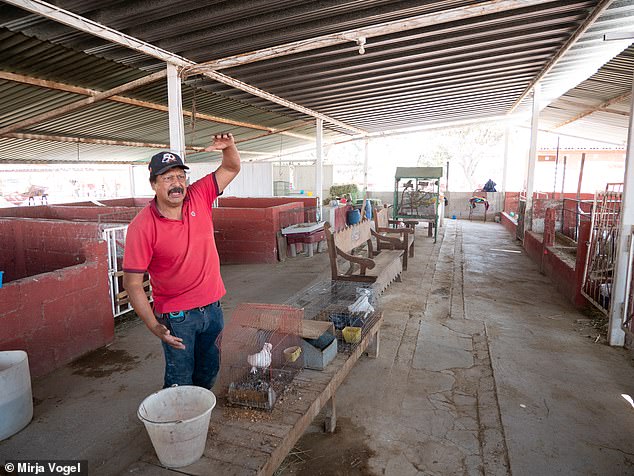
Mr Trejo in his farm where he keeps animals including cows, donkeys and llamas. He gestures the amount of water some families have per animal
'Some found their animals dead and others had to kill or sell their stock . . . when you lose all your animals and crops your whole future is in danger.'
There are more dried-up lakes a few miles south of Pedro Escobedo, a small town only a 15-minute drive from one of Microsoft Azure's three data centres. Local traders are up at 6am to sell beef, pork, chicken and fresh fruit and vegetables. But fish has been off the menu for several months.
'Prices for fresh food are crazy at the moment,' says one employee at the town's butcher. 'The farmers are running out of animals to sell and the little they have, they eat themselves.'
Two miles from one of Amazon's cloud data centres, we witness a fire on a dried-up farm. While the blaze cannot be blamed on data centres, the latter's insatiable thirst for water will surely not help. One local says: 'With this heat, these fires will keep coming and without enough water they can't be stopped.'
Dr Luzma Fabiola Nava, a Mexican expert in water management and governance, says starkly: 'Data centres' substantial water consumption poses challenges in regions already grappling with water scarcity and competing demands.' The overwhelming desire from the people of the drought-ridden towns of Queretaro is for their rights to water to be put first. But as their taps run dry, they can only watch while vast quantities are pumped through the pipes of AI data centres next door.

A young butcher discusses the soaring cost of meat and fresh vegetables in Pedro Escobedo, Queretaro, where drought is threatening the livelihoods of local businesses
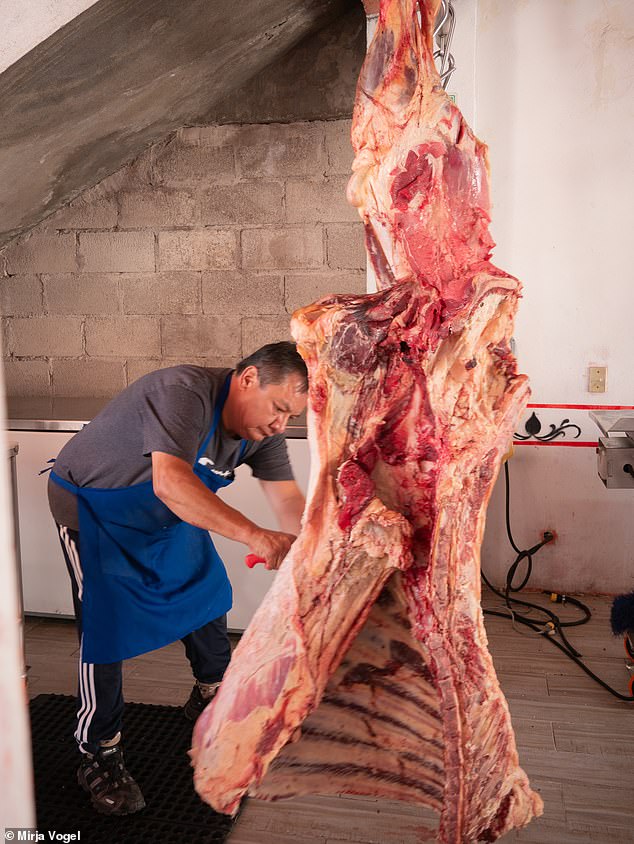
The boss sweeps his blade through the carcass of a pig, the only one hanging in the butcher's in Pedro Escobedo
Of the 12 underground aquifers in Queretaro, which are partly recharged by surface water sources like Lake Constitucion, eight are currently overexploited, according to local campaigners Spokeswomen of Mother Earth, who earlier this month urged the state to stop advertising Queretaro as an 'environmental paradise' for data centres.
Independent researchers, meanwhile, say the Mexican state faced a 90 per cent deficit in its aquifer reserves in March this year.
And what of Silicon Valley's billion-pound investment into its UK facilities?
When the Mail asked Microsoft where the power and water for its future operations would come from, it declined to comment, other than to point to previous statements from its president, Brad Smith, promising sustainable and carbon-free operations in the near future.
Its partner OpenAI also did not respond to requests to explain how it would tackle the problems of water and energy.
Google, which has 28 data centres in 11 countries, also declined to comment on how it would source energy and water for Waltham Cross, again simply providing old statements on how AI could solve all sorts of climate change problems in the fields of transportation, flood preparation and wildfires, and that would more than compensate for its activities. There are 461 data centres in the UK, the third highest number after the U.S. and Germany. All tech companies claim to be aiming for net-zero carbon emissions by using renewable energy, but environmental groups are sceptical.
'Big Tech has a history of saying 'Trust us, everything will be fine',' says Michael Khoo, director of Friends of the Earth's Climate Disinformation Project. 'If they were able to generate their own clean energy for each data centre, then great. But you just can't do this with a couple of wind turbines. A data centre's needs are far greater than that.
'When there is a shortfall between the clean renewable energy a corporation needs and what it uses, it usually says it will buy renewable power as though there is an excess of it. But where will all this power come from?
'The tech industry is partly a Ponzi scheme where they ask for more investment for an initiative that will solve the last problem they created. We don't have enough energy so we'll solve that by spending trillions on cold nuclear fusion, as Sam Altman, CEO of OpenAI — which created ChatGPT — has suggested. We don't have enough microchips, so we'll solve that by spending billions reinventing the chips market. It never ends.'
There seems little hope for the farmers of Queretaro, pincered between climate change and the insatiable thirst of its new data centre neighbours.
Only time will tell if their plight is a portent for the UK.










































































































































































































































































































































